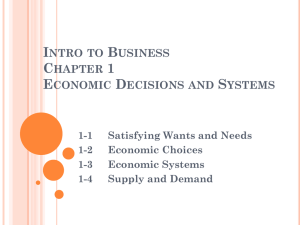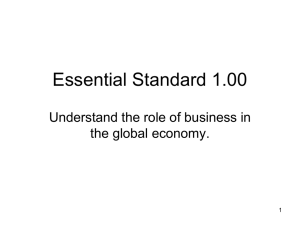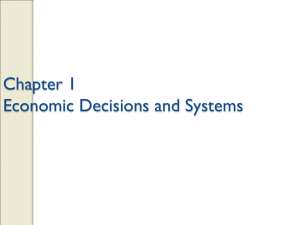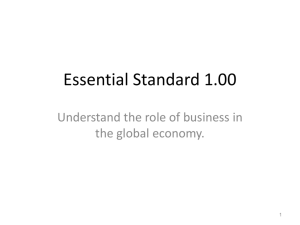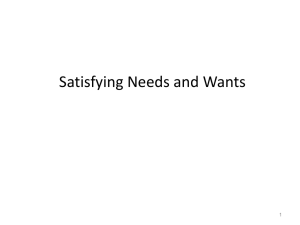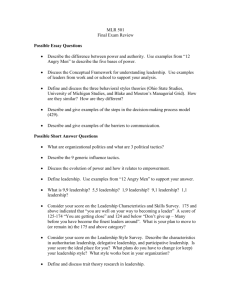1.01
advertisement
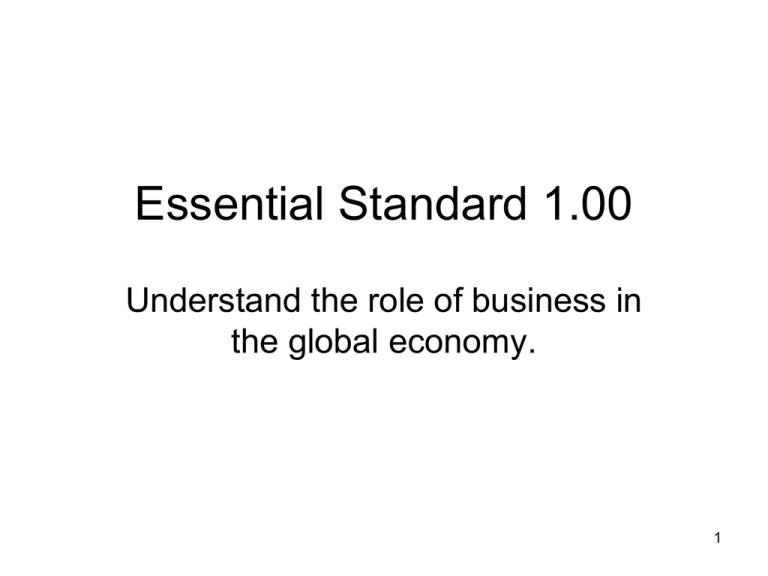
Essential Standard 1.00 Understand the role of business in the global economy. 1 Objective 1.01 Understand economic systems. 2 Topics • • • • • Satisfying needs and wants Basic economic problem Six steps of economic decision-making Main types for economic systems Market economy self-regulating principles 3 Satisfying Needs and Wants 4 Satisfying Needs and Wants • What are needs? • What are wants? 5 Satisfying Needs and Wants continued • What are goods? • What are services? • The United States economy is the largest producer of goods and services in the world. 6 Satisfying Needs and Wants continued • How do businesses use economic resources to produce goods and services? • The types of economic resources are: – Natural – Human – Capital 7 Satisfying Needs and Wants continued • Natural resources are raw materials produced by nature. Many natural resources are nonrenewable. • Human resources are the people who contribute physical and mental energy to the production process. 8 Satisfying Needs and Wants continued Capital resources are the tools, equipment, and buildings that are used to produce goods and services. 9 Satisfying Needs and Wants continued • The basic economic problem exists due to limited resources for satisfing unlimited needs and wants. • Scarcity is not having enough resources to satisfy the unlimited needs and wants. • The scarcity of resources for satisfying needs and wants influences choices. 10 Satisfying Needs and Wants continued • What is the purpose of economic decision-making? • What happens to choices in a tradeoff? • What is opportunity cost ? 11 Six steps of economic decisionmaking 12 Economic Decision-Making Economic decision-making is a means of choosing a course of action among several alternatives. 13 Economic Decision-Making continued The six steps in the economic decisionmaking process are: – Defining the problem – Identifying choices – Evaluating the advantages and disadvantages of each choice – Choosing one choice – Acting on the choice – Reviewing the decision 14 Economic Decision-Making continued Solve a problem Problem: Adjust the foundation of a house Choices: Ignore the problem Contact companies located in the same city Contact companies located in the next city Contact companies located in other cities 15 Economic Decision-Making continued • Some advantages: location of local companies, companies that guarantee of services, and companies that provides simple explanation of necessary services • Some disadvantages: prices for services and location of company in next city or other cities 16 Economic Decision-Making continued • Choosing one choice: A local company that guarantees services and provides simple explanation of services. • Acting on choice: Schedule for local company to provide services of adjusting foundation of house. 17 Economic Decision-Making continued • Reviewing decision: Routinely check on condition of foundation of house. 18 Main types of economic systems 19 Economic Systems What are the three economic questions that all economies must answer? 20 Economic Systems • An economic system is a nation’s plan for answering the three economic questions. • The main types of economic systems are: – Command or Communist – Market – Traditional – Mixed 21 Economic Systems • Who owns the resources in the main types of economic systems? – Command – Centered on family – Market – Government – Traditional – The people • Who answers the economic questions? 22 Market economy self-regulating principles 23 United States Economic System Capitalism allows the freedom of consumption and production of goods and services. The economic system of the United States is based on capitalism. 24 United States Economic System continued The four principles of U.S. economic system are: • Private property – can own, use, or dispose of things of value. • Freedom of choice – can make decisions independently and must accept consequences of those decisions. 25 United States Economic System continued • Profit – money left from sales after all of the costs of operating a business have been paid. • Competition – the rivalry among businesses to sell their goods and services. 26 Market Economy • What is the role of consumers in a market economy? • A consumer includes individuals, businesses, and government. 27 Market Economy continued • What is the role of producers in a market economy? 28 Market Economy continued The market economy is based on the principles of supply and demand. – Demand is the quantity of goods or services that consumers are willing and able to buy. – What are some examples of consumer demand? 29 Market Economy continued – Supply refers to the quantity of goods or services that businesses are willing and able to provide. – What are some examples of producers of supplies? 30 Supply and Demand Graphs Intro to Business, 6e, Thomson South-Western 31 Supply and Demand Graphs Intro to Business, 6e, Thomson South-Western 32 Supply and Demand Graphs • Market (equilibrium) price is the point where supply and demand are equal. Intro to Business, 6e, Thomson South-Western 33
